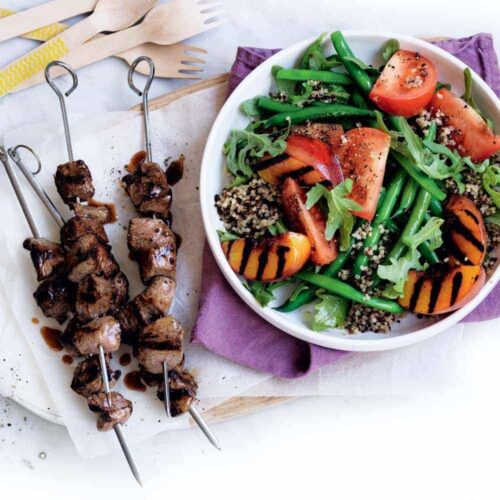
Gut bacteria influence everything from your immunity and weight to mood, so HFG dietitian Caroline Trickey reveals everything you need to know to keep your gut in great health.
Essential for digestion, your gut or gastrointestinal tract makes up a large part of your body: mouth, oesophagus, stomach, small intestine, large intestine, accessory digestive organs (gall bladder, liver and pancreas) and rectum.
The large intestine, or bowel, has the largest number and diversity of gut microbes. These microscopic living organisms, including bacteria, fungi and viruses, are known collectively as the gut microbiome. Bacteria is the most studied of these microbes, and the body actually contains more bacterial cells than human cells with DNA.
While some bacteria can be harmful, most are beneficial, and we need to have a balance of both.
What is the gut microbiome?
There are trillions of live microbes in your gut, anywhere from 500 to 1500 species, and their combination, or gut microbiome, is as unique to you as your fingerprint. A high level of microbe diversity is considered good for gut health, with microbiome composition being influenced by age, lifestyle and what you eat.
What gut bacteria do
Gut bacteria play a vital role from birth and beyond. Here’s a snapshot of what they do.
- Aid digestion, including breast milk
- Help with the absorption of nutrients, including calcium and magnesium
- Produce important nutrients, such as energy-boosting vitamin B and vitamin K, which is important for blood clotting and osteoporosis prevention
- Produce short-chain fatty acids (SCFAs) that protect and maintain the gut lining
- Metabolise cholesterol and bile acids
- Produce brain chemicals such as serotonin, which influences wellbeing.
- Support immunity.
Common questions about gut health
Q Is my gut healthy?
A One of the easiest ways to tell whether your gut is functioning effectively is through the absence of uncomfortable or painful gut-related symptoms. While producing gas is a normal part of digestion, ongoing or consistent excess gas is a sign your gut is not working optimally. So, too, is bloating, cramping, diarrhoea and constipation.
If you’re experiencing any of these symptoms, make an appointment to get checked out by your GP before you make changes to your diet. If all the tests come back negative, you may have irritable bowel syndrome (IBS) and be referred to a qualified dietitian to help manage symptoms.
Q Do I need probiotics?
A The balance of microbes in your gut can be upset if you have an infection or are using antibiotics, so your doctor may suggest using a probiotic to help prevent this from happening.
Probiotics are live bacteria commonly found in yoghurt and some fermented foods, such as sauerkraut and miso paste. They are also available as supplements. While research is still ongoing, they seem to help restore the gut microbiome to a healthy state after an imbalance.
The latest research also suggests that prebiotics may provide more health benefits than probiotics. Prebiotics are the fibre component of foods that boost the growth and activity of healthy bacteria. Some good food sources of prebiotics include artichokes, asparagus, apples, leeks, onion, garlic, barley and oats.
Q What’s all the fuss about fibre?
A Fibre has the biggest influence on your gut microbiome, increasing the activity, number and overall health of bacteria. Fibre is the indigestible part of plant-based foods that passes through to the large intestine where it can be fermented.
It’s this fermentation process that provides your gut microbiome with many health benefits.
There are three different types of fibre (see below) and we need to eat a balance of all three to support a healthy gut microbiome.
Insoluble fibre
This adds bulk and helps push your bowel motion through the bowel. It is slowly and only partially fermented.
Found in:
- Wholegrain flour and bread
- Wholegrain cereals and grains
- Wheat bran and rice bran
- Nuts
- Vegetable and fruit skin
Soluble fibre
This absorbs water and cholesterol, slows digestion and softens your bowel motion. It is highly fermentable.
Found in:
- Oats
- Psyllium husk
- Seeds
- Lentils and other legumes
- Barley
- Vegetable and fruit flesh
Resistant starch
This feeds the good bacteria that live in your bowel. It is completely fermented.
Found in:
- Firm, green slightly unripe bananas
- Beans (red kidney, lima, adzuki, black eyed, chickpeas, lentils)
- Green peas
- Rolled oats (uncooked)
- Barley
- Freekeh
- Cooked and cooled wholemeal pasta
- Cooked and cooled white and brown rice
- Cooked and cooled potatoes (in salads)
- Products that include BARLEYmax™
How much fibre do I need?
To stay regular, the recommended daily amount of fibre is 25g for women and 30g for men. Most Australians don’t consume this much fibre due to a preference for eating refined carbs over wholegrain ones, and relatively low intakes of fruit, vegies and legumes.
Increase your fibre intake gradually to allow time for your digestive system to adapt and therefore avoid bloating, wind or constipation. Add one new high-fibre food to your diet every two or three days and don’t forget to increase your water intake as this will help with digestion.
Fibre and bowel cancer
While we eat roughly the same amount of fibre as other Western populations, bowel cancer is the second most common cancer diagnosed in Australia.
Research has revealed that, as a nation, we eat a lot of wheat-based products, so it seems we’re getting enough insoluble fibre.
This suggests we should be focusing instead on eating a wider variety of fibres, in particular, more highly fermentable fibres such as soluble fibre and resistant starch.
Resistant starch is called that because it resists digestion in the small intestine and moves on to the large intestine, where it ferments and feeds healthy bacteria. Most importantly, its fermentation produces butyrate, the short-chain fatty acid that protects the bowel wall and reduces your risk of developing bowel cancer. It also supports healthy digestion and optimal immune function.
The CSIRO recommends consuming around 20g of resistant starch a day to improve gut health and help reduce the incidence of bowel cancer. This is almost four times the amount found in a typical Western diet!
10 ways to up your intake of resistant starches
- Choose an oat-based cereal for breakfast or make your own muesli
- Add oats to home-baked goodies
- Swap out wheat flour for chickpea or lentil flour
- When served hot, swap out regular potato for sweet potato or serve regular potato cold
- Stock up on frozen green peas to add to meals easily
- Incorporate more vegies into your breakfast, lunch and dinner
- Eat more cashews, because these have more resistant starch than other nuts
- Thicken soups and stews with barley or red lentils (or both!)
- Make salads using barley as a base
- Include legumes in meals at least four times a week.
Your high-fibre day on a plate
Breakfast
1 small banana, ½ cup rolled oats, 2 tsp mixed seeds (linseed or chia, sunflower, pumpkin seeds), ¹⁄³ cup fresh or frozen berries, yoghurt and/or milk of choice.
Lunch
Chicken, vegetable and barley soup or chicken and quinoa salad.
Dinner
Fish with lentils and grilled veggies or chilli con carne.
Snacks
Fresh fruit (banana, apple, peach, berries) and a handful of cashews.
Article sources and references
- Baker Institute. 2020. Dietary Fibre factsheet. Accessed December 2020https://www.baker.edu.au/-/media/documents/fact-sheets/baker-institute-factsheet-dietary-fibre.pdf
- CSIRO. 2020. Resistant starch facts. Accessed December 2020https://www.csiro.au/en/research/health-medical/nutrition/resistant-starch
- Dai et al. 2013. Probiotics and irritable bowel syndrome. World J Gast. 19(36): 5973-80.https://pubmed.ncbi.nlm.nih.gov/24106397/
- Fayet-Moore et al. 2018. Dietary Fibre Intake in Australia. Associations with Demographic, Socio-Economic, and Anthropometric Factors. Nutr 10(5): 599.https://www.ncbi.nlm.nih.gov/pmc/articles/PMC5986479/
- Harper et al. 2018. The role of bacteria, probiotics and diet in irritable bowel syndrome. Foods. 7(2): 13.https://pubmed.ncbi.nlm.nih.gov/29373532/
- Jacka et al. 2017. A randomised controlled trial of dietary improvement for adults with major depression. BMC Med. 15(1): 23.https://bmcmedicine.biomedcentral.com/articles/10.1186/s12916-017-0791-y
- Kelesidis T & Pothoulakis C. 2012. Efficacy and safety of the probiotic Saccharomyces boulardii for the prevention and therapy of gastrointestinal disorders. Ther Adv Gast. 5(2): 111-125.https://www.ncbi.nlm.nih.gov/pmc/articles/PMC3296087/
- McDonald et al. 2018. American gut: an open platform for citizen science microbiome research. mSystems. doi: 10.1128/mSystems.00031-18.https://msystems.asm.org/content/3/3/e00031-18
www.healthyfood.com










